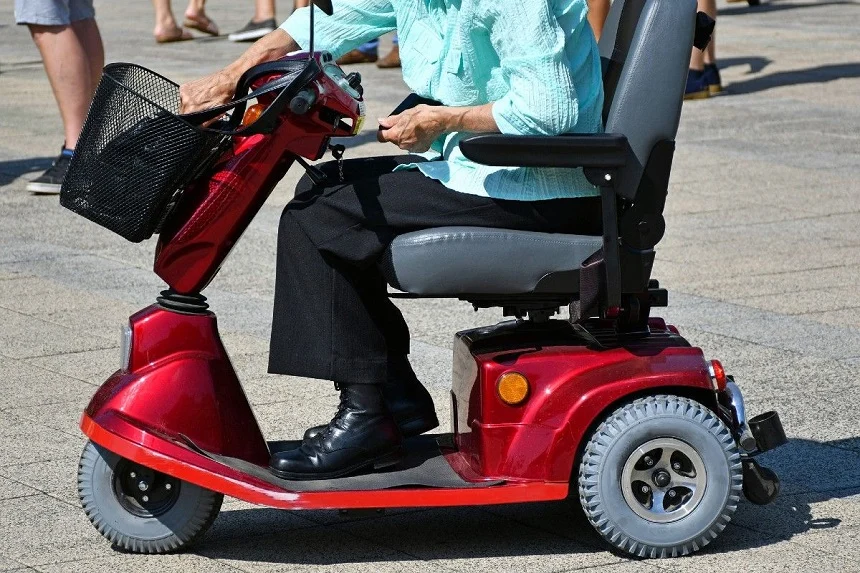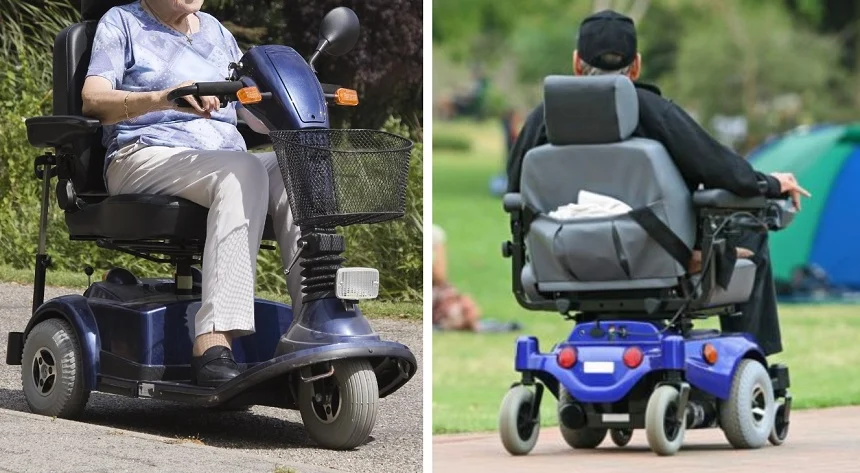 A wheelchair or a mobility scooter, which one should I get? This is one of the most asked questions by caregivers or people with disabilities looking to get around the home or neighborhood without being pushed around.
A wheelchair or a mobility scooter, which one should I get? This is one of the most asked questions by caregivers or people with disabilities looking to get around the home or neighborhood without being pushed around.
A power wheelchair and mobility scooter have the same common goal: giving mobility to people with disabilities or seniors. They can use them to move from one place to another, but they have many differences.
In this power scooter vs power wheelchair comparison article, we will show you the similarities and differences between both mobility machines.
Mobility scooters, also called power scooters or electric scooters, are single-occupant autonomous electric vehicles that people with disabilities can use for moving a fairly long distance.
Formerly used mainly on pedestrian routes by the elderly and disabled, many models are now suitable for transporting seniors even on the road or country lanes.
These machines are now quite popular among seniors. According to the UK Ministry of Transport, there are close to 300,000 mobility scooters in the United Kingdom.
The mobility scooter is equipped with a rechargeable battery ensuring a range of several miles, usually between 15 and 25 miles. It allows seniors to move relatively far and travel by plane (for models with an appropriate certificate).
This small electric vehicle makes it easier for seniors to stay at home and continue doing their favorite occupations, do their groceries, or go for a doctor’s appointment without depending on the availability of a third party. With a mobility scooter, you can maintain your independence and social life since you are no longer confined to your home.
Mobility scooters are considerably larger than wheelchairs, so they are often recommended for those looking to use them more outdoors and commuting around the city. These scooters are designed for city rides, excursions, and small commutes.
People who use motorized scooters generally still have some mobility but may need assistance, such as when symptoms develop, or they become tired.

Power wheelchairs, also called electric wheelchairs or motorized wheelchairs, are types of wheelchairs that can move users around in the home. The wheelchair is more for those who are heavily handicapped. It is exhaustive pushing a classic wheelchair for long hours, and some pathologies do not allow it anyway.
The power wheelchair, with its battery, can roll for 8 to 10 miles and up to 20 miles for some expensive models. Equipped with a joystick or control lever, it allows the person with a disability to rotate their wheelchair up to 360° and to move it forward and backward with a single finger.
They have four to six wheels, a seat, footrest but no handlebars. They have a small electric motor, which is operated through a joystick on the front of the chair.
Power wheelchairs are the best option for those who suffer from motor illnesses or have certain disabilities in the legs. They allow movement with hardly any effort on the arms.
As far as power wheelchairs go, they are designed precisely for all-day use and to be on while doing most of your day-to-day activities. In contrast, scooters are generally designed for small commutes, city rides, or even excursions and people who can still make use of their legs to some extent.

Power wheelchairs are devices used by people with motor disabilities, helping them move without manual support. At the same time, scooters allow people with reduced mobility to move independently over longer distances. But there’s more to these mobility machines. Here, you’ll find out
The power wheelchair is operated with only one hand. This allows people with very low motor skills to continue with a level of movement in and out of their homes.
On the other hand, the scooters come with a handlebar or rudder, where it is necessary to have both hands functional. They are designed for older people with difficulty moving around but not for severe or degenerative motor illnesses.
Most power wheelchairs are suitable for movement within the house. However, scooters are maneuverable outdoors.
The battery run-time of scooters is greater than that of wheelchairs. They are designed for long stretches such as city walks, excursions, and trips.
In terms of safety, power wheelchairs are more efficient and navigable as they offer greater support.
Power chairs tend to be more compact, lighter, and easier to maneuver. Wheelchairs can be folded and stored more easily than scooters. So your transportation is much simpler and more convenient. Their average weight varies between 50 and 250 pounds.
Scooters can also be folded for indoor storage or transport in vehicles (such as pickup trucks or mini-vans) when you want to take them on the road. Their average weight varies between 85 and 400 pounds.
With scooters, the seat can be adjusted in height for the best riding comfort. The distance from the seat to the base, as well as the distance to the rudder or handlebar – these features, are significant for tall people who need balance between weight and height.
Power wheelchairs don’t have the option of adjusting the height every time you want. Motorized scooters do not have as many functions as power wheelchairs do in postural support. This makes a significant difference in overall comfort.
Scooters are designed for use outside the home, not implying that they cannot be easily brought into a home. However, its design is not for doing tasks or moving around a house or apartment. This is because its chair is not designed for sitting at a table or a desk, since they have a handlebar and headlight in front.
Power wheelchairs, on the other hand, are smaller in size and are designed like chairs. This makes them perfect for handling chores, sitting at the table, desk, etc.
On the other hand, scooters, unlike chairs, allow longer and faster journeys outside the home. They let you traverse unstable surfaces with the help of their four or three wheels (depending on the model). They also have comfortable seats in different modalities, similar to those of a car in terms of its shape.
Check out the video below that compares mobility scooters and power wheelchairs.
Answering what is best between a mobility scooter and an electric wheelchair will depend on each person’s individual needs.
Power scooters are gaining popularity among older adults who can still use their legs and hands but find it challenging to move around long distances and may need some assistance.
As we mentioned in the scooter vs. power wheelchair comparison, scooters are preferred for folks who spend quality time outdoors. They are safe and equipped with a robust suspension that can handle many types of terrain.
The electric wheelchair is an excellent device for people with motor illnesses or disabilities in their legs. It facilitates mobility without the need to exert effort with the arms.